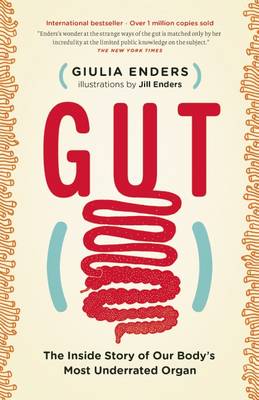
With quirky charm, rising science star Giulia Enders explains the gut's magic, answering questions like: Why does acid reflux happen? What's really up with gluten and lactose intolerance? How does the gut affect obesity and mood? Enders's beguiling manifesto will make you finally listen to those butterflies in your stomach: they're trying to tell you something important.
I listened to this as a follow up to I Contain Multitudes knowing full well going into it that it was written to appeal to people generally not interested in science, but I wanted this, to a degree. I was looking for straight-forward information that I could use to apply to my everyday choices.
I got both what I was expecting, and what I was looking for. Most of my science reading friends are going to find the writing in this one tedious to the extreme. This is meant to be a very introductory text, and Enders' intended audience knows little to nothing about the hard science of the human body and her generous use of metaphors to help readers along is probably effective, but it nearly drove me up the wall. Katy Sobey, the narrator, did an excellent job: her voice was clear, pleasant and easy to understand, but she sounds young and at times the combination of her youthful sounding voice and the metaphors (and especially when the text used 'tummy' - a word I despise) gave the whole thing a very surreal, children's book vibe, that at the beginning was difficult to take seriously, although I quickly got used to it.
While I'd never suggest this book for a Flat Book Society read, I did get a lot out of it; both information I was hoping for (about specific bacteria strains that research has shown useful) and information I wasn't looking for but am thrilled to have found. I know first hand the risk of eating cookie batter; the resulting bout of Salmonella left me with a hefty dose of fear for raw eggs. Gut has taken a world of stress off my shoulders. Specifically, Chickens do not harbour Salmonella naturally; it comes from feeding them cheap grains tainted by reptile feces and it does not exist inside the egg (just the shell). I'm never going to be a raw egg eater, but it's nice to know that if my eggs are sourced from organically fed chickens (mine), and I clean the shells before using them, I can once again dip into the cookie dough - and not be the freaked-out-aunt when my nieces want to lick the spoon!
These are the practical types of information I was hoping I'd find in this book, so I'm not at all disappointed. For anyone wanting to know more about how their body works with, and depends on, bacteria and the food they eat, but does not have an interest in the nitty-gritty science-y details, I'd recommend this book happily. It's well-written, easy to understand (if metaphor heavy), balanced and informative.
Reading updates
-
Started reading
-
14 April, 2018:
Finished reading
-
14 April, 2018:
Reviewed
